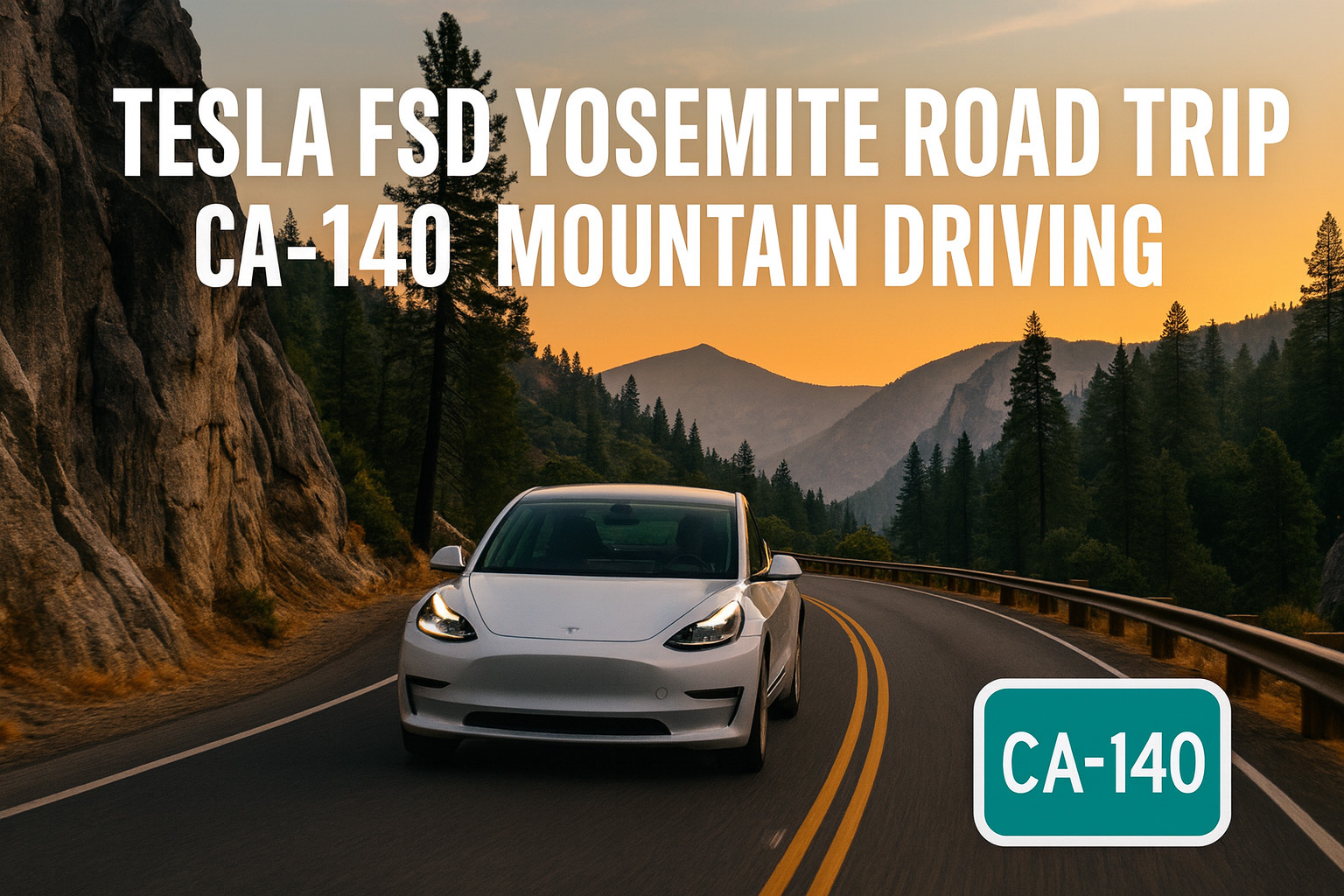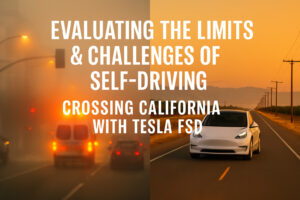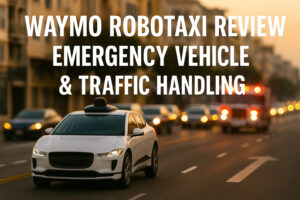Tesla FSD Yosemite Road Trip: CA‑140 Mountain Driving

Crossing California with Tesla FSD: San Francisco → Yosemite Final Chapter
Introduction: Wrapping Up a Five-Part Saga
The epic journey from San Francisco to Yosemite National Park has finally reached its conclusion.
In this finale, which starts near Merced, the scenery shifts dramatically from flat farmland to towering mountains, pushing Tesla FSD to tackle winding mountain roads for the first time.
As the culmination of our five-part series, this post explores both the promise and the limits of autonomous driving while showcasing California’s remarkable variety.
Series Recap
📽️ Parts 1–5 at a Glance
Part 1: Downtown San Francisco
Tesla FSD Urban Driving in San Francisco: Hands-On Review
Tested FSD in the city’s complex traffic while visiting icons like the Painted Ladies and the Golden Gate Bridge for an urban-style autonomous experience.
Part 2: Oakland & the Freeway
Tesla FSD vs Waymo: Hidden San Francisco Views & Yosemite Drive
Crossed the Bay Bridge and stretched FSD’s legs on the freeway, enjoying wind-farm vistas and seeing the system shine at highway speeds.
Part 3: Central Valley
SF to Yosemite Drive with Tesla FSD: Central Valley
Drove past some of the world’s largest nut orchards near Modesto, marveling at endless rows of almonds and walnuts that reveal the scale of California agriculture.
Part 4: Technical Challenges
Evaluating the Limits and Challenges of Self-Driving: Crossing California with Tesla FSD
Observed and analyzed several FSD quirks around Turlock—particularly near big rigs and at tricky merges—to understand autonomy’s real-world limits.
Part 5: Arrival in Yosemite
Completed the final, mountainous leg from Merced through Mariposa into Yosemite, taking FSD from flatlands to challenging mountain roads.
CA-140: The Gateway to Yosemite
The final leg unfolds on California State Route 140, a 103-mile (166 km) corridor that starts in Merced, passes through Mariposa, and ends at Yosemite National Park’s Arch Rock Entrance.
Few drives in California offer a more dramatic transition—from flat farmland to rugged mountain terrain.
🛣️ Highlights of CA-140
- Starting point: Merced (agricultural heartland)
- Midpoint: Mariposa (tiny town of about 1,200 residents)
- End point: Arch Rock Entrance, Yosemite National Park
- Total length: 103 miles (166 km)
- Drive time: 45 min – 1 hr from Mariposa to Yosemite
- Scenery: Pastures → rolling hills → mountain landscapes
Mariposa: The Butterfly Town
“Mariposa” means “butterfly” in Spanish, a nod to the beautiful species found in this region.
Perched at roughly 600 m (≈ 2,000 ft) above sea level, this small town is a key waypoint for Yosemite-bound travelers and a popular lunch stop on Japanese tour itineraries.
It even has a Tesla Supercharger, making it an easy break for EV road-trippers.
Yosemite National Park: A Treasure Trove of Wilderness
Designated a UNESCO World Heritage site in 1984, Yosemite National Park is famed for its towering granite cliffs, lush forests, and crystal-clear rivers and waterfalls.
Spring snowmelt turns streams pristine, ancient giant sequoias—some thousands of years old—stand sentinel, and diverse wildlife enchants every visitor.
Glacier Point: Yosemite’s Show-Stopping View
From Glacier Point you’ll soak in Yosemite’s most iconic vista, staring straight at Half Dome.
It’s one of the best views you can reach by car, making it a highlight of any Yosemite itinerary.
🏔️ Fun fact: The three lines in The North Face logo are a stylized depiction of Half Dome’s sheer north face.
If you’re a fan, take a moment to admire the real-life inspiration!
Giant Sequoias: Living Witnesses From Antiquity
One of Yosemite’s star attractions is its giant sequoias—trees that live 1,000–3,000 years on average and up to 4,000 years at the extreme.
With trunk bases 5–9 m (≈ 16–30 ft) across and circumferences of 15–30 m (≈ 49–98 ft), their sheer size makes surrounding trees look downright skinny.
🌲 Astonishing Traits of Giant Sequoias
- Lifespan: 1,000–4,000 years
- Bark thickness: about 30 cm (≈ 12 in) or more
- Longevity secret: thick bark shields them from insects, disease, and fire
- Tannin content: natural tannins block pests and fungi
- Growth pattern: slow-growing but incredibly resilient over time
Traces of Wildfire & Nature’s Cycle
The dead trees you see in Yosemite are scars from past wildfires.
In California’s arid climate, naturally occurring fires—sparked by lightning, especially “dry lightning,” or occasionally by sun-heated, tinder-dry leaves—are an essential part of the ecosystem.
Giant sequoias that outlive these blazes are proof of nature’s almost mystical resilience.
Tesla FSD: A New Challenge on Mountain Roads
Technical Challenges in Mountain Terrain
⛰️ Issues Observed During Mountain Driving
Cornering instability: On tight bends the car sometimes swings so wide that it nearly drifts into the oncoming lane—a serious concern on cliff-side roads.
Speed management issues: FSD can slow to a crawl in sharp curves, potentially holding up following traffic on single-lane mountain routes.
Overly sensitive gaze detection: Glancing toward the inside of a curve may trigger a “Please keep your eyes forward” warning, revealing a slight mismatch with natural human driving behavior.
Network Connectivity Challenges & Workarounds
Cell service is patchy in Yosemite’s surrounding mountains. FSD relies primarily on GPS and cameras, so it can still drive without a connection, but keep these points in mind:
📶 Navigation Tips in Mountain Terrain
- Set your destination beforehand: Do this while you still have a signal.
- Route-change risk: If FSD chooses a different path, it can’t re-route without data.
- Getting lost: Few road signs mean a wrong turn could leave you stranded with low battery.
- Precautions: Download offline maps in advance and make sure you’re well charged.
In the future, satellite services such as SpaceX’s Starlink may bring reliable connectivity even to remote mountain areas.
Latest Tesla Tech Developments
Next-Gen Model Y (Codename: Juniper)
Unveiled for the Chinese market in January 2025, the revamped Model Y features major upgrades aimed at long-distance travel—ideal for journeys like ours.
🚗 Key Upgrades on the New Model Y
- Range: 719 km (CLTC) / 635 km (WLTC)
- Quieter cabin: acoustic glass throughout
- Rear-seat comfort: dedicated touchscreen and power-reclining seats
- Cargo capacity: 2,130 L+ with the second row folded
- Design focus: caters to China’s chauffeur-driven market
NHTSA Investigation & “Actually Smart Summon”
The U.S. National Highway Traffic Safety Administration (NHTSA) has launched a probe into roughly 2.6 million Teslas equipped with the “Actually Smart Summon” feature after receiving reports of 16 collisions.
The inquiry is part of ongoing efforts to enhance the safety of autonomous-driving technology.
Charging Options in Yosemite
🔋 EV Charging in Yosemite National Park
Supercharger (Yosemite View Lodge)
- 0→50 % charge: about 10–15 min
- 0→80 % charge: roughly 25–30 min
- Location: at a hotel just outside the park
Free Chargers Inside the Park
- 10–20 % top-up: 1–2 hours
- 0→80 % charge: 7–8 hours
- Best use: plug in overnight while parked
Note for Glacier Point & Similar Spots
No chargers are available at the summit, so start the climb with a full battery.
On the way back down, regenerative braking usually means you’ll use almost no charge.
Coexisting With Wildlife
Yosemite is home to black bears, deer, coyotes, and many other wild creatures—especially active at dawn and dusk. Signs reading “Speeding Kills Bears” highlight how crucial it is to obey speed limits for wildlife protection, and FSD’s steady speed control can actually help keep animals safe.
🐻 Wildlife Watching & Safety Tips
- Best viewing times: early morning and late evening
- Food storage: keep all food properly secured to avoid attracting bears
- Trash management: never leave litter that could lure wildlife
- Maintain speed limits: prevent collisions with animals
- Seasonal note: some roads close in winter due to snow
Practical Touring Tips
Best Practices for Visiting Yosemite
🌅 Time of day matters: Yosemite’s weather can change fast—clear mornings often turn cloudy by afternoon. Start early to make the most of the good light and clear skies.
👟 Gear up: Many trails are slick with loose rock and sand, so sturdy hiking boots are a must. Water stations are few and far between, so pack plenty of drinking water.
🧢 Protect against UV: The high elevation means stronger sunlight—be sure to wear a hat and apply sunscreen.
Recommended Sights
- Glacier Point: The best viewpoint you can reach by car
- Tunnel View: A classic panorama of the entire valley
- Yosemite Falls Area: Trails of varying difficulty levels
- Giant Sequoia Grove: Meet ancient, colossal trees up close
- Squirrel Spotting: Fun little discoveries during forest walks
Series Finale: Lessons & Takeaways from 196 Miles
🎯 Significance of a Mission Accomplished
Technical achievements: We demonstrated that Tesla FSD delivers practical performance across a wide range of roads—from dense city streets to mountain passes.
The long-distance fatigue reduction was striking, allowing us to complete the 4-hour-30-minute journey in comfort.
Geographic diversity: In one trip we took in California’s many faces: San Francisco’s urban skyline, Oakland’s industrial zone, the agricultural sweep of the Central Valley, and finally the high country of Yosemite.
Cultural discoveries: From cutting-edge Silicon Valley campuses to some of the world’s largest nut orchards and natural wonders that have endured for millennia, the journey highlighted the harmony of modern technology, traditional industry, and ancient nature.
The State of Autonomous Driving Today
This long-haul test confirmed that FSD has genuinely reached a practical level of usability.
At the same time, mountain curves and maneuvers around large trucks highlighted areas that still need refinement.
Crucially, these gaps aren’t hard limits—they’re targets for continuous improvement through future updates.
Looking Ahead
With Unsupervised FSD on the horizon, the new-generation Model Y rolling out, and Starlink promising better connectivity in remote mountains, the prospect of a truly seamless, fully autonomous road trip is getting closer.
This journey marked an important step toward that future.
Conclusion: A Journey Where Technology Meets Nature
Our 196-mile (315 km) odyssey from San Francisco to Yosemite—told over five installments—has reached its end.
It was a true snapshot of modern California, where cutting-edge autonomous tech meets landscapes shaped over thousands of years.
Tesla FSD is not flawless, yet it dramatically reduced the strain of long-distance driving and freed up time to focus on everything beyond the wheel.
That extra mental space let us dive deeper into the scenery outside and the experiences at each stop—undeniably elevating the quality of the trip.
Perhaps the most striking discovery was the sheer diversity packed into a single state.
From world-leading tech campuses to enormous agricultural operations and primeval natural wonders, California’s wide-ranging environments and cultures may be its greatest allure.
🚗 Try FSD Yourself: EcoDrive offers rental cars equipped with Tesla’s Full Self-Driving (FSD), so when you’re in California, be sure to give it a try!
Our Services
We offer comprehensive automotive solutions—buy, sell, rent, and repair in one place.
Car Sales
Browse our lineup of quality used cars with transparent pricing and up to a two-year warranty on select models.
View InventoryAuto Repair
Get expert service from our certified Toyota Master Mechanic. We primarily service Toyota vehicles.
Schedule ServiceTrade-in / Sell
We pay top dollar for your vehicle—especially hybrids. Count on fair, transparent appraisals.
Get EstimateCar Rentals
Choose between fuel-saving hybrid rentals and a Tesla with Full Self-Driving Capability—both at competitive rates.
Reserve Now





